In May 2018, Cacaopod and I took a 16-day trip around northern Europe. We had several focuses: art, trains, and chocolate!!! My first report was on Hamburg, Germany. Now, onto Berlin!
We only had a couple of days in Berlin, so we concentrated on art and chocolate. I’m saving historical sites for another trip (fingers crossed). After spending a day on Museum Island where there are 5 museums full of amazing ancient art (like the bust of Nefertiti and Ishtar Gate), we stopped by a couple of nearby chocolate shops.
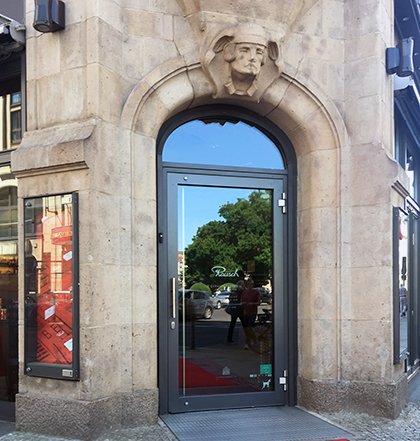
Chocolate department store
Our first stop, Rausch Schokoladenhaus (chocolate house), might be the largest chocolate store in the world. The shop is over 1,000 meters square, plus it has a chocolate cafe upstairs and a deli/to-go spot in the same building.
It looks like an old-school upscale department store — if each department in the store sold a different type of chocolate. The cases and displays are paneled in dark wood like a traditional jewelry store; but instead of rings, watches, and necklaces, there’s a section for truffles and pralines, another for handmade inclusion bars, and others for traditional bars, gift boxes and baskets, souvenirs, molded and dipped chocolates, cooking/baking chocolate, and single-origin bars.
You could go overboard here buying chocolate gifts. I was tempted by their single-flavor truffles packed in pint ice cream cartons, chocolate cigars in wooden cigar boxes, and cute molded Berlin bears in different chocolates. There are also lots of gift basket options and inclusion bar options, so you could find something unique for everybody.


Incomparable
My first thought was that it’s like an upscale See’s, our local old-school chocolate, since they both have long histories (Rausch was founded in 1918, See’s in 1921), and the first counter in the store is a long line of truffles and pralines like in a typical See’s shop. But Rausch has a much larger product line and more amenities. Woodhouse Chocolate in St. Helena has a somewhat similar fancy European jewelry store vibe and lots of inclusion bars, but they have nowhere near the selection or services either.
There really is nothing local to compare Rausch to. It’s a family-owned company now in its fifth generation; they make EVERYTHING chocolate-related; they started doing single-origin bars when most local bean-to-bar makers were still in school; and they even own some cacao plantations to source their beans from.
They also decorate the Schokoladenhaus with chocolate sculptures, which are well done with lots of detail, like a replica of the Reichstag government building in Berlin, one of the Titanic, and an airplane suspended above the displays. With so many plusses, Rausch seemed it could be the über-chocolate maker.
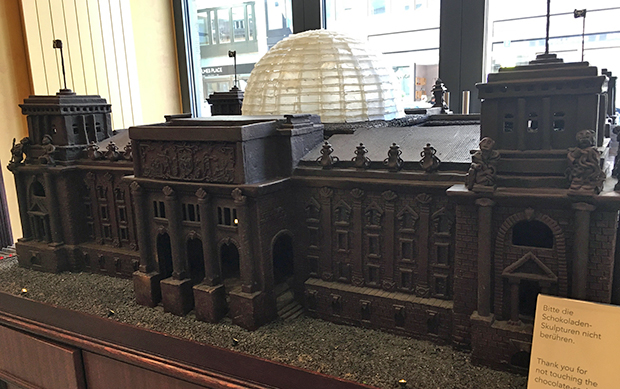

Maybe not


All of those strengths don’t mean that Rausch chocolate is superior to our local options. Their inclusion bars didn’t look as appealing to me as our local artisan bars (like Socola Chocolatier’s). And their truffles and pralines seemed similar to See’s. We tried a couple, Mocha and Mango, which were too sweet for me.
Although it was too sweet, the seasonal Mango truffle was interesting: It had a liquid mango caramel center with good mango flavor in a very hard white chocolate shell covered with bits of dried orange peel that tasted like orange marmalade. I liked the contrast between the super hard outside and liquid inside; and the chewy bits of orange peel were unique.
Maybe with more time I could have found pieces I liked. I hope to get the opportunity. I’d also like to try their chocolate cafe where even the savory dishes are made with chocolate.
Singular single-origins
Rausch did have a winner in my eyes in their single-origin bars. Single-origin is big now, lots of bean-to-bar makers have popped up recently, and it’s a bit of a Wild West scene: You take a chance every time you try a new bar as to whether it will be tasty or inedible. So much can go wrong on the path from tree to palate.
Rausch seems to avoid the hazards in making single-origin chocolate. But they have been making single-origin bars since 1998, so they probably made all their mistakes years ago and can now be counted on to deliver reliable chocolate even with risky single-origin beans.
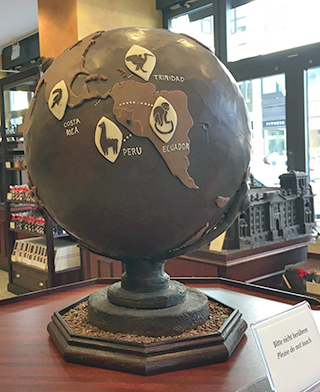

We tried and liked all 4 Rausch single-origin bars in their Plantagen line. The 60% Peru was fruity with a hint of vanilla; it had an almost milk chocolate taste. The 70% Ecuador was chocolatey and fruity; it wasn’t bitter, but maybe a little sour. The 75% Costa Rica was slightly bitter, but very chocolatey and nutty. And the 80% Trinidad was not bitter, really! It was very smooth, like a nice intense shot of chocolate.
These would be a nice way to introduce someone to single-origin chocolate. Not only are the 4 chocolates distinct, but they are all delicious with good mouthfeel, so a person won’t be turned off by bitter, weird-tasting or rough-textured chocolate.
Attractive & informative
And I have to mention the packaging. The full-size bars would make nice gifts. The front of each bar features a laser-cut design of cacao pods and an animal that represents the country of origin (for Peru, it’s a llama; for Ecuador, it’s a monkey). Each bar is wrapped in a dark brown box with white text and a bright accent color that peeks through the laser-cut design.
The back of each bar has a circular histogram that shows visually the how much of each flavor note exists in the bar. I didn’t catch all the notes the graphs expressed, but I thought they were helpful and educational — and good for expanding my German vocabulary!
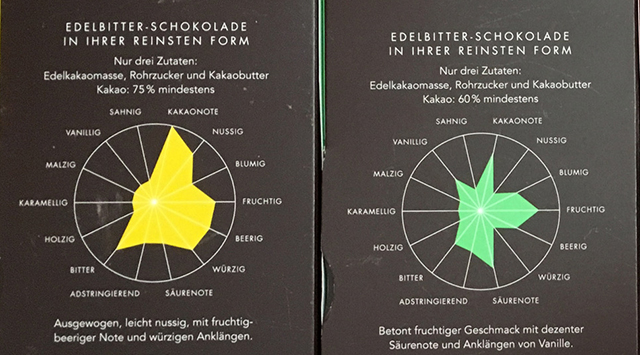

As if that is not enough in the thoughtful-packaging department, Rausch also offers the Plantegan line in 2 smaller sizes down to bite-size, so you don’t have to make a big financial commitment to try the line. Unfortunately, Rausch does not delivery to the US, but if you ever find yourself in Berlin, check out the store for the experience and some good gifts for your less-adventurous chocolate-loving friends.
Rausch Schokoladenhaus Berlin: Charlottenstraße 60, 10117 Berlin
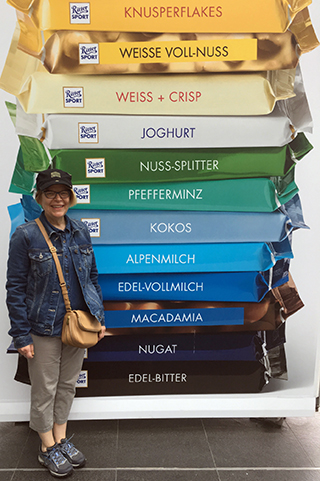

Colorful chocolate world
If there is one German chocolate people are familiar with, it’s probably Ritter Sport. The sweet squares come in a variety of flavors, with each one sporting a different color wrapper.
They are fairly common in the US, and they are ubiquitous in Germany. When we arrived in town on the train from Hamburg, we were greeted by big, big Ritter Sport banners hanging throughout the Berlin Hauptbahnhof (main train station).
While I am not a big Ritter Sport fan, I did want to check out Ritter Sport Bunte Schokowelt (Colorful Chocolate Word) in Berlin. The flagship store, opened in 2009, is near the Rausch superstore and is described as 3 floors of Ritter Sport fun. I think that is accurate. It is definitely not a refined chocolate experience, but I think Ritter Sport fans would love this place, and there’s something for the rest of us too, as long as we keep our expectations realistic. It definitely has a bit of a tourist-trap vibe.
You are greeted on the first floor by a long create-your-own-bar counter. I skipped the custom-bar bar because there are only about 20–30 ingredients you can add to generic Ritter Sport dark, milk or white chocolate; and you don’t even make it yourself: you order it from the staff behind the counter who mix it up for you. Kinda like going to an ice cream shop and ordered a scoop with some sprinkles, only it’s a chocolate bar they assemble for you instead.
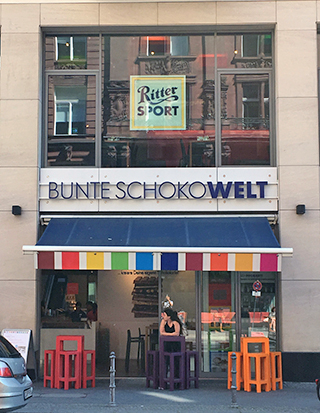

Past the bar in the back is the colorful shop, where you can buy all things Ritter Sport. Downstairs is a workshop for kid-oriented chocolate classes. Upstairs is an interactive chocolate exhibit and the Ritter Sport cafe, which features desserts and drinks made from Ritter Sport chocolate, along with non-chocolate snacks and drinks.
Lots of options, lots of deals
I wasn’t enticed to stock up, but other customers around us were happily filling baskets with chocolates and RS-branded items and exclaiming about the deals. Supposedly, this is the place to get the best prices on Ritter Sport in all of Berlin, and they carry the most flavors.
I was interested to see if they were making any bars with the newest chocolate: Ruby chocolate from Barry Callebaut. It was first available commercially in Asia in January with Nestlé’s ruby KitKat bars. And I heard a promised Spring 2018 release of ruby chocolate to chocolatiers in Europe, so I thought Ritter Sport might be a source for this new flavor, but alas, no.
They do have custom flavor mixes that are only available in the store and for a limited time. We got the 4 spring flavors, which were all too sweet for us. That’s not surprising though: Sugar is the first ingredient listed on all of the custom flavors we tried.
‘Natural blonde’
They did have a bar with the second most recent “new chocolate”: Dunkel + Blond was a 2-layer bar, with a layer of 50% dark chocolate (they call it half-bitter) on top of blond chocolate. Blond chocolate was supposedly first made when a pastry chef left white chocolate heating too long, and it caramelized. Valrhona was the first company to offer blond chocolate commercially. Ritter Sport’s version seems like a bit of a cheat: They add caramel syrup to white chocolate to give it the blond color and caramel/butterscotch flavor. I liked the concept of dark and blond a lot more than I liked the actual bar.
Himbeer-Waffel was a milk chocolate bar with rice crispies, low-fat yogurt and raspberry filling. I liked this one best because the raspberry flavor was pronounced, and the rice crispies were crunchy. Cassis Joghurt was also milk chocolate with black currant flavored low-fat yogurt and pieces of black currant. It was similar to the Himbeer-Waffle, but not as fruit forward, and more tart.
The fourth bar, Weisse Mango Maracuja, was white chocolate with pieces of dried mango and chewy passionfruit-flavors bits. Sounds interesting, but too sweet!
In addition to the special bars, there were also small one- and two-bite chocolates in a plethora of flavors, some standard RS flavors like yogurt or caramel, and some more unique ones, like Jamaica Rum, Amaretto, Chocolate Mousse, and Stracciatella Crisp. Unfortunately, it’s still RS chocolate, so I can’t recommend them unless you already like Ritter Sport.
Chocolate edutainment
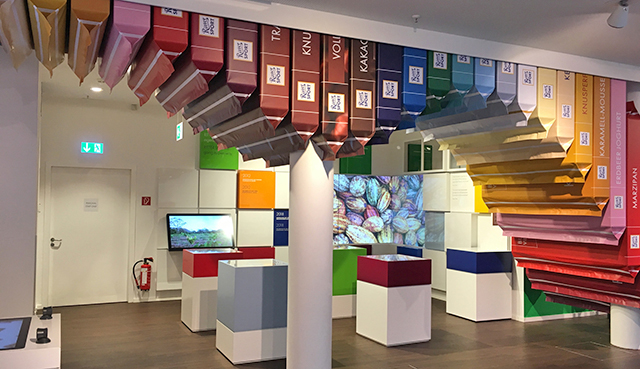



We did enjoy the interactive chocolate exhibit upstairs. It’s small, but attractive, and gives a good quick overview of the process of chocolate making with videos and display cases. Plus you can make your own souvenir “postcards” to email to friends!
Ritter Sport Bunte Schokowelt Berlin: Französische Straße 24, 10117 Berlin
Next stop: Berlin artisan chocolate



